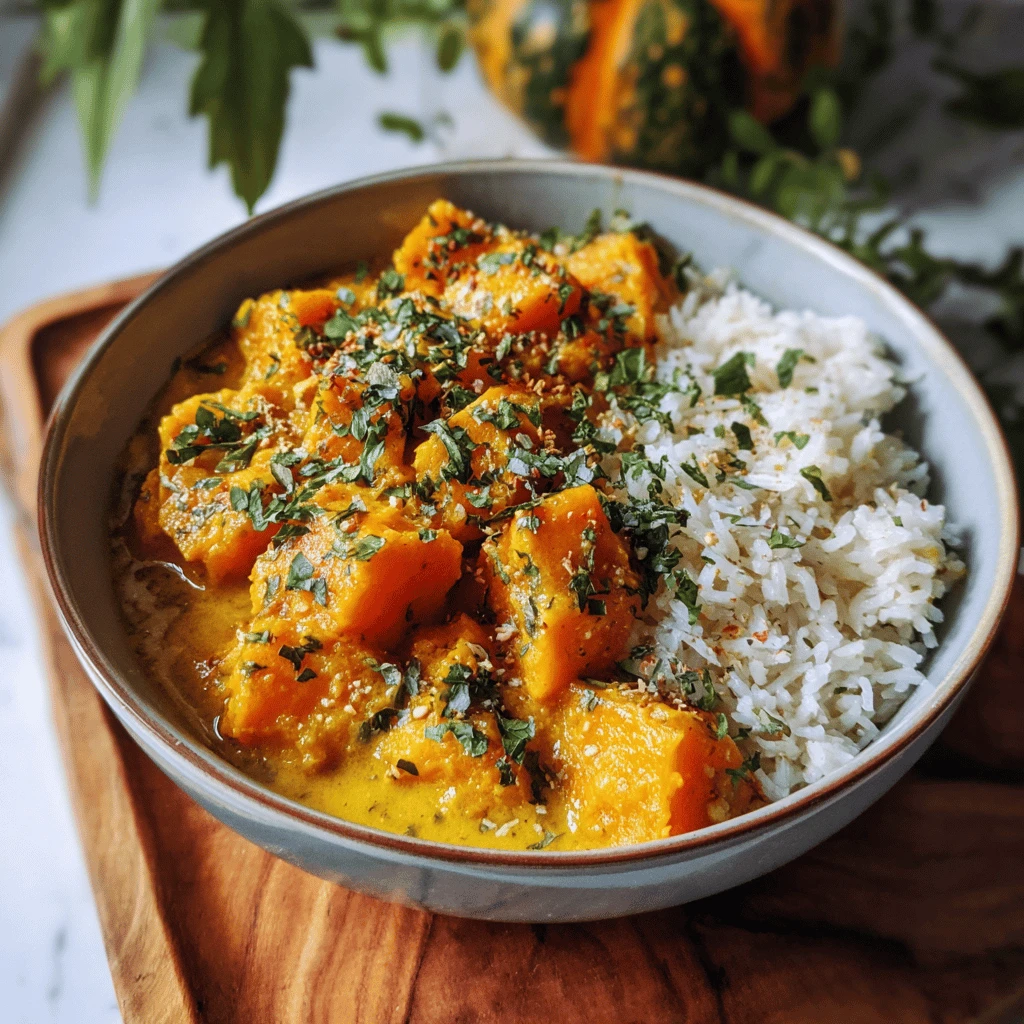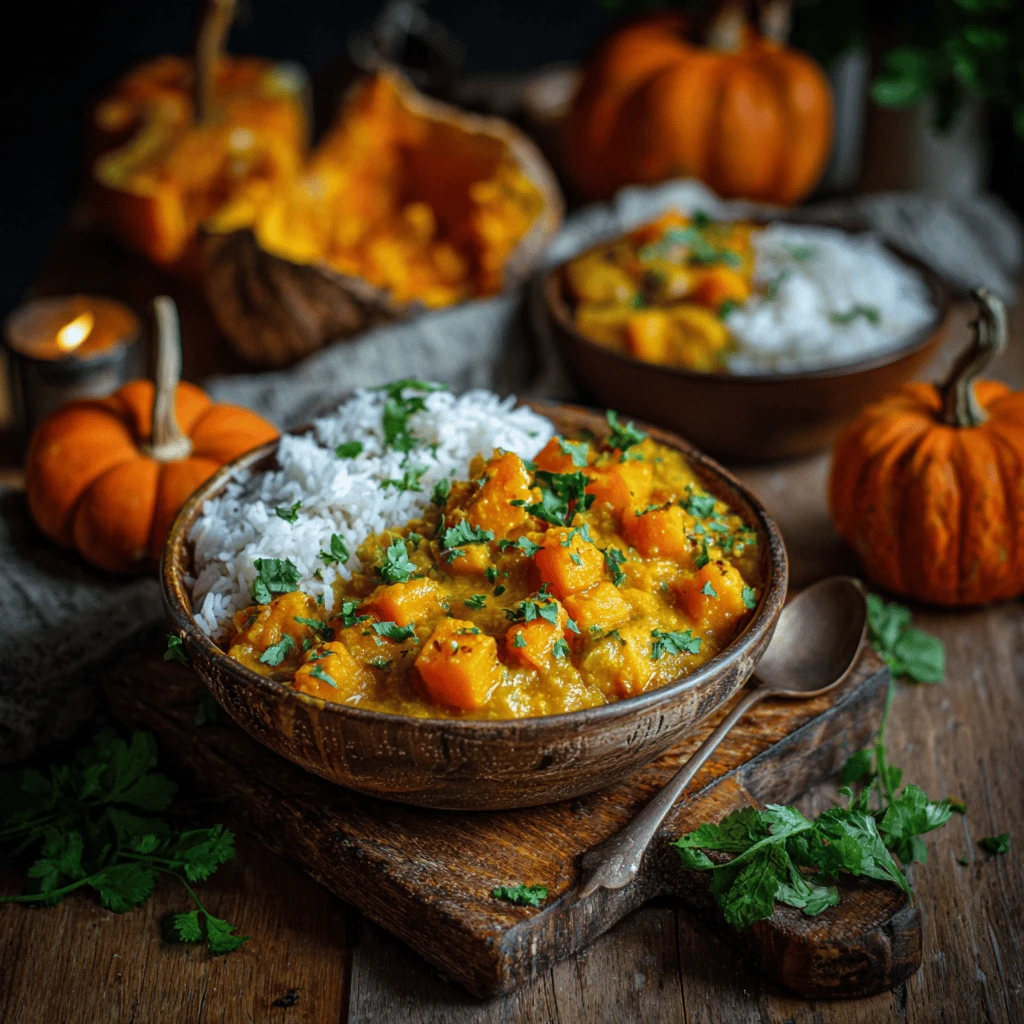Simple Easy Pumpkin Curry
Pumpkin curry is a vibrant and flavorful dish perfect for autumn and beyond. Its creamy texture, subtly sweet pumpkin flavor, and aromatic spices create a comforting and satisfying meal. This guide provides a simple, easy-to-follow recipe and delves into the variations, nutritional benefits, and serving suggestions for creating the perfect pumpkin curry.
The Ultimate Simple Pumpkin Curry Recipe
This recipe focuses on simplicity and accessibility, using ingredients readily available in most supermarkets. It yields a flavorful and satisfying curry that can be customized to your spice preference.
Ingredients:
- 1 tablespoon coconut oil (or vegetable oil)
- 1 onion, chopped
- 2 cloves garlic, minced
- 1 inch ginger, grated
- 1 red bell pepper, chopped
- 1 (15-ounce) can pumpkin puree (not pumpkin pie filling)
- 1 (13.5-ounce) can coconut milk (full-fat or light)
- 1-2 tablespoons red curry paste (adjust to taste)
- 1 teaspoon turmeric powder
- 1/2 teaspoon cumin powder
- 1/4 teaspoon cayenne pepper (optional, for heat)
- 1/2 teaspoon salt (or to taste)
- 1/4 teaspoon black pepper
- 1 cup vegetable broth (or water)
- 1 (15-ounce) can chickpeas, drained and rinsed (or other beans like kidney or cannellini)
- 1 cup spinach (or other greens like kale or bok choy)
- Lime wedges, for serving
- Fresh cilantro, for garnish (optional)
- Cooked rice, for serving
Instructions:
1. Sauté Aromatics: Heat the coconut oil in a large pot or Dutch oven over medium heat. Add the chopped onion and cook until softened, about 5 minutes. Add the minced garlic and grated ginger, and cook for another minute until fragrant.
2. Add Bell Pepper and Spices: Add the chopped red bell pepper to the pot and cook for 3-4 minutes, until slightly softened. Stir in the red curry paste, turmeric powder, cumin powder, and cayenne pepper (if using). Cook for 1 minute, stirring constantly, to bloom the spices.
3. Incorporate Pumpkin and Coconut Milk: Pour in the pumpkin puree and coconut milk. Stir well to combine, ensuring no lumps remain.
4. Simmer the Curry: Add the vegetable broth (or water), salt, and pepper. Bring the curry to a simmer, then reduce the heat to low, cover, and cook for 15-20 minutes, stirring occasionally, allowing the flavors to meld.
5. Add Chickpeas and Greens: Stir in the drained and rinsed chickpeas and spinach. Cook for another 5 minutes, or until the spinach is wilted and the chickpeas are heated through.
6. Serve and Garnish: Serve the pumpkin curry hot over cooked rice. Garnish with fresh cilantro and a squeeze of lime juice.
Customizing Your Pumpkin Curry
The beauty of pumpkin curry lies in its adaptability. Here are several ways to customize the recipe to suit your tastes and dietary needs:
Protein Variations:
- Tofu: Add cubed, firm tofu for a plant-based protein boost. Pan-fry or bake the tofu before adding it to the curry for a firmer texture.
- Chicken or Shrimp: For a non-vegetarian option, add cooked chicken or shrimp during the last 5-10 minutes of cooking time. Ensure the chicken is cooked through and the shrimp is pink and opaque.
- Lentils: Red lentils cook quickly and add a hearty texture to the curry. Add about 1/2 cup of red lentils along with the vegetable broth, and adjust the cooking time accordingly.
Vegetable Additions:
- Sweet Potatoes: Diced sweet potatoes complement the pumpkin flavor and add a satisfying sweetness. Add them along with the bell pepper to ensure they cook through.
- Cauliflower or Broccoli: These vegetables add a nutritious crunch to the curry. Add them during the last 10 minutes of cooking to maintain their texture.
- Green Beans: Fresh or frozen green beans can be added during the last 5 minutes of cooking for a vibrant green addition.
Spice Level Adjustments:
- Mild: Omit the cayenne pepper and use a mild red curry paste.
- Medium: Use 1 tablespoon of red curry paste and a pinch of cayenne pepper.
- Spicy: Use 2 tablespoons of red curry paste and 1/2 teaspoon of cayenne pepper. Consider adding a finely chopped chili for extra heat.
Liquid Consistency:
- Thicker Curry: Use full-fat coconut milk and reduce the amount of vegetable broth. Simmer uncovered for a longer period to allow the curry to thicken.
- Thinner Curry: Use light coconut milk and add more vegetable broth.
Vegan Adaptations:
- This recipe is naturally vegan if you use vegetable broth. Ensure your red curry paste is also vegan, as some brands may contain shrimp paste or fish sauce.
Nutritional Benefits of Pumpkin Curry
Pumpkin curry is not only delicious but also packed with nutritional benefits.
Pumpkin:
- Rich in Vitamins: Pumpkin is an excellent source of vitamin A, which is essential for vision, immune function, and skin health. It also contains vitamin C, vitamin E, and several B vitamins.
- High in Antioxidants: Pumpkin is rich in antioxidants like beta-carotene, which can help protect your body against cell damage from free radicals.
- Good Source of Fiber: Pumpkin is a good source of dietary fiber, which promotes healthy digestion and helps regulate blood sugar levels.
Coconut Milk:
- Healthy Fats: Coconut milk contains healthy medium-chain triglycerides (MCTs), which can be easily digested and used for energy.
- Source of Minerals: Coconut milk provides minerals like potassium, magnesium, and iron.
Spices:
- Anti-inflammatory Properties: Spices like turmeric, ginger, and cumin have anti-inflammatory properties that can help reduce inflammation in the body.
- Antioxidant Activity: Many spices are rich in antioxidants that protect against cell damage.
Overall Benefits:
Pumpkin curry is a nutrient-dense meal that provides a good balance of carbohydrates, protein, and healthy fats. It’s a great way to incorporate more vegetables and plant-based protein into your diet. The spices contribute to its flavor profile and offer additional health benefits. This dish is also customizable, making it suitable for various dietary needs, including vegan, vegetarian, and gluten-free diets (always check your curry paste ingredients!).
Serving Suggestions and Pairings
Pumpkin curry is a versatile dish that can be served in various ways and paired with different sides to create a complete and satisfying meal.
Serving Suggestions:
- Over Rice: The classic way to serve pumpkin curry is over cooked rice. Basmati rice or jasmine rice are excellent choices, as their fragrant aroma complements the curry’s flavors.
- With Naan Bread: Serve with warm naan bread for dipping into the creamy curry sauce.
- As a Soup: For a lighter meal, serve the pumpkin curry as a soup. You can add more vegetable broth to achieve a soup-like consistency.
- With Quinoa or Couscous: For a healthier alternative to rice, serve the curry over quinoa or couscous.
Side Dish Pairings:
- Raita: A cooling raita (yogurt-based dip) can provide a refreshing contrast to the warm spices of the curry.
- Mango Chutney: The sweet and tangy flavor of mango chutney complements the savory and subtly sweet flavors of the pumpkin curry.
- Cucumber Salad: A simple cucumber salad with a light vinaigrette can add a refreshing element to the meal.
- Roasted Vegetables: Roasted vegetables like cauliflower, broccoli, or sweet potatoes can add extra nutrients and texture to the meal.
Garnishing Ideas:
- Fresh Cilantro: A sprinkle of fresh cilantro adds a bright, fresh flavor to the curry.
- Lime Wedges: A squeeze of lime juice brightens the flavors of the curry and adds a touch of acidity.
- Toasted Pumpkin Seeds: Toasted pumpkin seeds add a crunchy texture and a nutty flavor.
- Red Pepper Flakes: For an extra kick of heat, sprinkle with red pepper flakes.
- Coconut Flakes: Toasted coconut flakes add a touch of sweetness and a tropical flavor.
By experimenting with different serving suggestions, side dish pairings, and garnishing ideas, you can create a unique and personalized pumpkin curry experience.
Troubleshooting and Tips for Success
Making pumpkin curry is generally straightforward, but here are some common issues and tips to ensure a successful outcome:
Curry Too Thick:
- Add More Liquid: Gradually add more vegetable broth or water until you reach your desired consistency.
Curry Too Thin:
- Simmer Longer: Simmer the curry uncovered for a longer period, allowing the liquid to evaporate and the curry to thicken.
- Add a Thickening Agent: Stir in a cornstarch slurry (1 tablespoon cornstarch mixed with 2 tablespoons cold water) and simmer for a few minutes until thickened.
Curry Lacks Flavor:
- Adjust Spices: Add more red curry paste, turmeric, cumin, or cayenne pepper to enhance the flavor.
- Add Salt: Salt is essential for bringing out the flavors of the curry. Add salt gradually, tasting as you go.
- Add Acid: A squeeze of lime juice or a splash of vinegar can brighten the flavors of the curry.
Curry Too Spicy:
- Add Coconut Milk or Yogurt: Stir in more coconut milk or a dollop of yogurt to cool down the spice.
- Add Sugar: A pinch of sugar can help balance the heat.
Pumpkin Flavor Too Strong:
- Add More Coconut Milk or Vegetable Broth: Diluting the curry with more liquid can reduce the intensity of the pumpkin flavor.
- Add Acid: A squeeze of lime juice or a splash of vinegar can help balance the sweetness of the pumpkin.
Tips for Success:
- Use Good Quality Ingredients: The quality of your ingredients will directly impact the flavor of your curry. Use fresh spices and high-quality pumpkin puree.
- Bloom the Spices: Cooking the spices in oil before adding the other ingredients helps to release their flavors and aromas.
- Taste and Adjust: Taste the curry throughout the cooking process and adjust the seasoning as needed.
- Don’t Overcook the Vegetables: Add vegetables that cook quickly (like spinach) towards the end of the cooking time to prevent them from becoming mushy.
- Let the Flavors Meld: Simmering the curry for at least 15-20 minutes allows the flavors to meld together and develop a richer taste.
Frequently Asked Questions (FAQ)
- Can I use fresh pumpkin instead of canned pumpkin puree? Yes, you can! Roast or steam the pumpkin until tender, then puree it in a food processor or blender. You’ll need about 2 cups of fresh pumpkin puree to replace one can of pumpkin puree.
- Can I freeze pumpkin curry? Yes, pumpkin curry freezes well. Allow it to cool completely before transferring it to an airtight container. Freeze for up to 3 months. Thaw in the refrigerator overnight before reheating.
- How long does pumpkin curry last in the refrigerator? Pumpkin curry will last for 3-4 days in the refrigerator. Store it in an airtight container.
- Can I make this curry in a slow cooker? Yes, you can! Sauté the onions, garlic, and ginger in a skillet first. Then, transfer all the ingredients to a slow cooker and cook on low for 6-8 hours or on high for 3-4 hours. Add the spinach during the last 30 minutes of cooking.
- What kind of curry paste should I use? Red curry paste is commonly used in pumpkin curry, but you can also experiment with other types of curry paste, such as yellow or green curry paste, to create different flavor profiles.
- Is pumpkin curry healthy? Yes! Pumpkin curry is rich in vitamins, antioxidants, and fiber.




